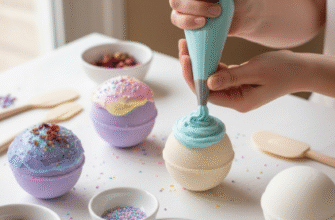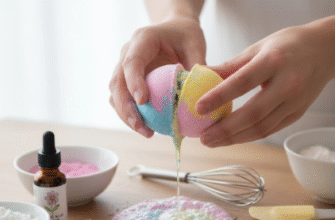Feeling like your skin needs a serious refresh? We often focus on facial skincare, pampering our complexions with serums and masks, but the skin on our body deserves just as much attention. Over time, dead skin cells accumulate, leaving our skin looking dull, feeling rough, and sometimes even contributing to pesky issues like clogged pores or ingrown hairs. Fortunately, achieving smoother, brighter body skin doesn’t require expensive spa treatments. One of the most effective and budget-friendly solutions is hiding in plain sight, possibly already in your bathroom cabinet: Epsom salt.
Creating your own body scrub using Epsom salt is incredibly simple and offers immediate gratification. Forget complicated ingredient lists or fancy packaging. This is about getting back to basics with a natural exfoliant that works wonders. Let’s dive into why Epsom salt makes such a fantastic base for a body scrub and how you can whip up your own batch for instant skin relief.
Understanding the Exfoliation Powerhouse: Epsom Salt
First things first, what exactly is Epsom salt? Despite its name, it’s not the same as the table salt you sprinkle on your food. Epsom salt is actually a naturally occurring mineral compound of magnesium and sulfate. Its crystalline structure is key to its exfoliating prowess. The grains are typically coarse enough to effectively slough away dead skin cells and rough patches, yet they dissolve readily in water, making cleanup easy and reducing the risk of over-scrubbing compared to some other physical exfoliants.
While many associate Epsom salt with soothing baths intended to ease muscle soreness (often attributed to the magnesium), its primary benefit in a scrub is purely physical exfoliation. It acts as a mechanical agent, buffing away the outermost layer of dead skin that can obscure your skin’s natural radiance. This simple action can dramatically improve skin texture and appearance.
Why Bother Exfoliating Your Body Anyway?
Regular body exfoliation is more than just a pampering step; it’s a fundamental part of maintaining healthy, vibrant skin. Here’s why incorporating it into your routine, perhaps with an Epsom salt scrub, is so beneficial:
- Smoother, Softer Skin: This is the most immediate and noticeable benefit. By removing the rough, dead layer of skin cells, you reveal the newer, softer skin underneath. Areas prone to roughness, like elbows, knees, and heels, see significant improvement.
- Brighter Appearance: Dead skin cells can scatter light unevenly, leading to a dull or lackluster appearance. Exfoliation removes this layer, allowing your skin to reflect light more effectively, resulting in a brighter, more radiant look.
- Enhanced Moisturizer Absorption: Why waste your lovely body lotions and creams on a layer of dead skin? Exfoliating clears the path, allowing moisturizers to penetrate more deeply and work more effectively, leading to better hydration.
- Helps Prevent Ingrown Hairs: By keeping the skin surface clear of dead cell buildup, you reduce the chances of hair follicles becoming trapped or blocked as hair regrows after shaving or waxing. Regular exfoliation can help hairs grow out freely.
- Unclogs Pores: Just like on your face, pores on your body can become clogged with dead skin cells, sweat, and sebum, potentially leading to body acne (bacne, chest breakouts). Exfoliation helps keep these pores clear.
- Stimulates Skin Renewal: The physical act of scrubbing can gently stimulate circulation and encourage the natural process of skin cell turnover.
The Perks of Using Epsom Salt Specifically
While sugar scrubs and coffee scrubs are also popular DIY options, Epsom salt brings its own unique advantages to the exfoliation party:
- Effective Texture: The grain size provides satisfying and efficient exfoliation for the body (it’s generally too coarse for the delicate facial skin).
- Readily Available & Affordable: You can find large bags or cartons of Epsom salt at most drugstores, supermarkets, and garden centers for a very reasonable price.
- Dissolves Easily: Unlike some natural exfoliants that might leave residue, Epsom salt dissolves in the warm water of your shower or bath, making rinsing off simple.
- Customizable: It serves as a perfect neutral base for adding other beneficial ingredients like carrier oils and essential oils to tailor the scrub to your preferences.
Whipping Up Your Basic Epsom Salt Body Scrub
Ready to create your own skin-smoothing concoction? It truly couldn’t be easier. Here’s a foundational recipe:
Ingredients:
- 1 cup Epsom salt
- 1/2 cup Carrier Oil (adjust amount for desired consistency)
- Optional: 5-10 drops of essential oil for fragrance (ensure it’s skin-safe)
- Optional: 1 teaspoon Vitamin E oil (for extra nourishment and preservation)
Choosing Your Carrier Oil:
The carrier oil binds the salt, provides slip for easier application, and deeply moisturizes the skin. Popular choices include:
- Coconut Oil: Solid at room temperature, melts on skin contact. Very moisturizing, has a pleasant natural scent. Use fractionated coconut oil if you prefer it to remain liquid.
- Olive Oil: Rich in antioxidants and very hydrating. Can have a stronger scent. Choose extra virgin for higher quality.
- Sweet Almond Oil: A lighter oil, easily absorbed, rich in Vitamin E. Good for most skin types.
- Jojoba Oil: Closely mimics the skin’s natural sebum, making it well-tolerated and balancing.
- Grapeseed Oil: Very light and quickly absorbed, good for oilier skin types.
Instructions:
- In a clean, dry bowl, combine the Epsom salt and your chosen carrier oil.
- Mix well until the salt is evenly coated with the oil. Adjust the oil amount if needed – add more for a looser scrub, less for a denser one.
- If using, stir in the essential oils and Vitamin E oil until thoroughly combined.
- Transfer the scrub to an airtight container (a glass jar with a lid works perfectly). Store it in a cool, dry place away from direct sunlight.
How to Use Your Homemade Epsom Salt Scrub Effectively
Using your scrub correctly maximizes benefits and minimizes potential irritation:
- Timing is Key: The best time to exfoliate is during a warm shower or bath. The warmth and steam help soften the skin and open pores, making exfoliation more effective.
- Wet Your Skin: Stand under the shower stream for a few minutes or soak in the bath before applying the scrub. Never apply a coarse scrub to dry skin.
- Apply Gently: Scoop out a small amount of scrub. Using gentle but firm pressure, massage it onto your damp skin in circular motions. Start from your feet and work your way up towards your heart – this can help stimulate circulation.
- Focus on Rough Spots: Pay extra attention to areas that tend to get dry or rough, like your feet (especially heels), knees, and elbows. Be gentler on more sensitive areas like the chest and neck. Never use this coarse scrub on your face or delicate intimate areas.
- Rinse Thoroughly: Once you’ve scrubbed your entire body (avoiding sensitive zones), rinse off completely with warm water. The salt should dissolve away, leaving behind the moisturizing oil.
- Pat Dry: Gently pat your skin dry with a clean towel. Avoid vigorous rubbing, which can irritate freshly exfoliated skin.
- Moisturize Immediately: This is crucial! Apply your favorite body lotion, cream, or oil while your skin is still slightly damp. This locks in moisture and nourishes the newly revealed skin cells.
Important Safety Note: Be extremely careful when using oil-based scrubs in the shower or bathtub. The oil can make surfaces very slippery! Consider placing a non-slip mat in your shower or tub. Rinse the floor thoroughly after use to remove any oily residue.
Frequency: How Often Should You Exfoliate?
Listen to your skin! For most people, exfoliating 1 to 3 times per week is sufficient. If you have very sensitive skin, start with once a week and see how your skin responds. Over-exfoliation can lead to irritation, redness, and compromise your skin’s natural barrier, so moderation is key. Signs of over-exfoliation include tightness, shininess, sensitivity, or breakouts.
Getting Creative: Customizing Your Epsom Salt Scrub
The basic recipe is fantastic on its own, but feel free to experiment with additional ingredients for added benefits or sensory appeal:
- Honey: A natural humectant, honey draws moisture to the skin. Add a tablespoon of raw honey to your basic recipe for extra hydration. It also has soothing properties.
- Ground Coffee: Add a couple of tablespoons of used or fresh coffee grounds. Coffee offers extra exfoliation, a stimulating scent, and caffeine is often touted in skincare for its temporary tightening effect (though results vary).
- Citrus Zest: Finely grated lemon, orange, or grapefruit zest adds a bright, uplifting fragrance and contains natural acids that can contribute to skin brightening. Use about 1 tablespoon of fresh zest per cup of salt. Be mindful if you have very sensitive skin, as citrus can sometimes be irritating.
- Dried Herbs or Flowers: Crushed dried lavender buds, chamomile flowers, or rosemary can add a lovely aroma and potentially some subtle botanical benefits. Ensure they are finely ground to avoid being too scratchy.
Always remember to patch test any new ingredient combination on a small area of your skin (like the inner arm) before applying it all over your body, especially if you have sensitive skin or known allergies.
Embrace Simple, Effective Skincare
Making and using an Epsom salt body scrub is a wonderfully simple act of self-care. It connects you to natural ingredients and delivers tangible results – smoother, softer, more radiant skin – almost instantly. It’s proof that effective skincare doesn’t need to be complicated or costly. By buffing away the old, you make way for the new, leaving your skin feeling refreshed, revitalized, and ready to absorb moisture.
So next time your skin feels a bit blah, reach for that humble bag of Epsom salt. Mix it with your favorite oil, maybe add a scent you love, and treat yourself to an invigorating scrub. It’s an affordable luxury that provides genuine relief and leaves your body feeling pampered and polished. Give it a try and feel the difference for yourself!








